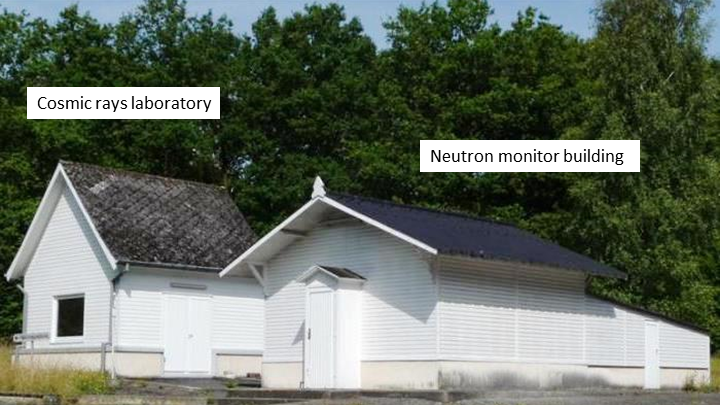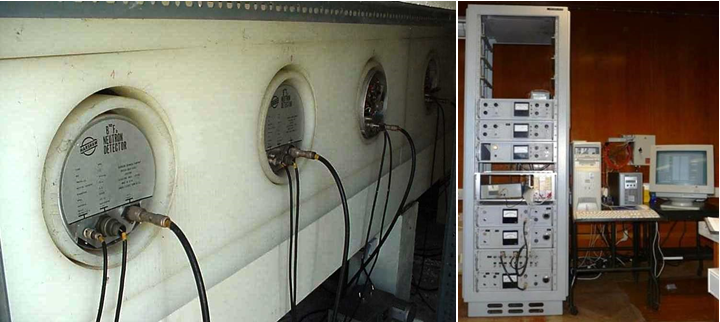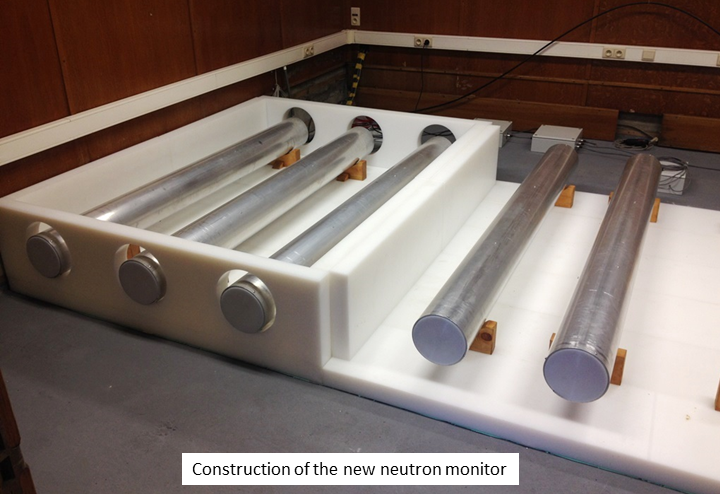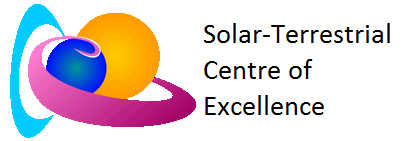Neutron Monitor
The RMI Geophysical Centre in Dourbes (Sapundjiev et al., 2017) hosts the only cosmic rays observatory in Belgium, where a neutron monitor is utilised for permanent observations of the cosmic ray intensity.

A neutron monitor is a ground-based detector designed to measure the number of high-energy charged particles (mainly protons and Helium nuclei) striking the atmosphere from the outer space.
Neutron monitors consist of the following main parts:
- Reflector. The reflector is the outer part enclosing the neutron monitor, consisting of proton-rich material — paraffin used in the early days, polyethylene more recently. This material is (largely) transparent to the (cascade) high-energy neutrons induced by the cosmic rays while low-energy neutrons of “environmental”, i.e. not induced by cosmic rays, cannot penetrate it.
- Producer. The producer is made out of high-purity lead, Pb. Fast neutrons that get through the reflector interact with the lead to produce lower energy neutrons. This amplifies the cosmic ray signal while producing neutrons that cannot easily escape the reflector.
- Moderator. The moderator, also a proton rich material like the reflector, slows down the neutrons now confined within the reflector, which makes them more likely to be detected.
- Proportional Counter/s. The proportional counter is a special metal tube filled with gas (most commonly used is Boron Trifluoride, BF3). After slow neutrons are generated by the reflector, producer, moderator, and so forth, they collide with a nucleus in the counter tube and cause it to disintegrate. This nuclear reaction produces energetic charged particles that ionise the gas in the tube, thus producing an electrical signal that can be detected and the occurrence accounted for
The fact that, finally, neutrons are detected gives this cosmic ray detector its name—neutron monitor.
At the RMI Geophysical Centre in Dourbes, the cosmic ray intensity is constantly measured with a standard 9-tube NM64 neutron monitor (3 units of 3 counters) which has been in operation since 1965 (Jodogne, 1970; Bossy and Jodogne, 1972).

A second neutron monitor is under construction next to the site of the currently operated monitor (Sapundjiev et al., 2015, 2016). The new monitor will be of the same type (NM64) and will complement the existing monitor; however, upon completion, the new one will be fully independent and thus would be able to provide measurements in case of degradation/failure of the old one. The modern design of the new monitor and its new peripheral electronics, combined with the better housing conditions, should provide for a prolonged exploitation period, higher counting rates and sensitivity to solar modulation, reliability and consistency of the measurements.

The neutron monitor remains a state-of-the-art instrument for cosmic ray observations by carrying out measurements of the secondary neutron component of the cosmic rays on the ground (Stankov et al., 2012). After pressure correction, this component would follow closely the primary cosmic rays intensity, i.e. would reproduce the variations of the cosmic rays intensity high above the station. However, before any useful information can be extracted from the raw neutron monitor measurements, missing records need to be recovered and the data has to be filtered and corrected. For space weather applications, all these steps has to be carried out in real time and answer to a strong requirements among which—to minimize the introduction of spurious data (spikes) and to eliminate any possibility for removal of correct original data. For the purpose, a Real Time Automatic Data Correction (RTADC) algorithm has been developed (Sapundjiev et al., 2013, 2014).
The RMI neutron monitor provides measurements data in real time to the International Neutron Data Base (NMDB).
References:
Jodogne, J.C. (1970): Mesure permanente de la multiplicité du rayonnement cosmique secondaire dans un moniteur NM64. Annales de la Soc. Scient. de Bruxelles, Vol.84, No.11, pp.253–256.
Bossy, L.G., J.C. Jodogne (1972): Utilisation à l'I.R.M. d'un mini-ordinateur dans les systèmes de mesures ionosphériques et du rayonnement cosmique. Bull. Sci. AIM, Vol.85, No.4, pp.245–254.
Stankov, S., J.C. Jodogne, S. Spassov (2012): Cosmic Rays — A Review. Pres. RMI Conference on Cosmic Rays, 18 Apr 2012, Brussels, Belgium. (download)
Sapundjiev, D., S. Stankov, J.C. Jodogne (2013): Data analysis of Dourbes neutron monitor data for solar events forecast. Proc. European Space Weather Week (ESWW), 18–22 Nov 2013, Antwerp, Belgium. (download)
Sapundjiev, D., M. Nemry, S.M. Stankov, J.C. Jodogne (2014): Data reduction and correction algorithm for digital real-time processing of cosmic ray measurements: NM64 monitoring at Dourbes. Advances in Space Research, Vol.53, No.1, pp.71–76, (doi:10.1016/j.asr.2013.09.037) (download)
Sapundjiev, D., S. Stankov, J.C. Jodogne (2015): On the optimisation of the construction of a ground-based neutron monitor for galactic cosmic ray monitoring and space weather applications. Proc. International Cosmic Ray Conference (ICRC), 30 July – 6 August 2015, The Hague, The Netherlands. (download)
Sapundjiev, D., S. Stankov, J.C. Jodogne (2016): Present status and modernisation of the Dourbes Cosmic Ray Observatory for improved space weather research and forecasting. Proc. European Space Weather Week (ESWW), 14–18 Nov 2016, Ostende, Belgium. (download)
Sapundjiev, D., T. Verhulst, S. Stankov, J.C. Jodogne (2017): The Belgian space weather observatory in Dourbes. Pres. IAU Symposium 335 “Space Weather of the Heliosphere: Processes and Forecasts”, 17–21 July 2017, Exeter, UK. Pres.ID#IAU-17-IAUS335-0489 (download)

